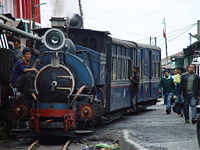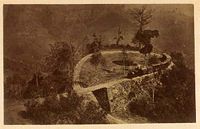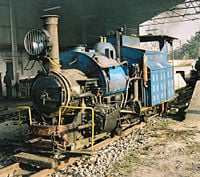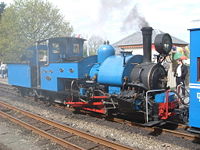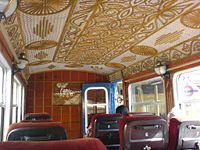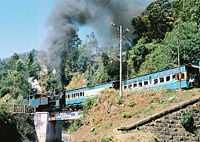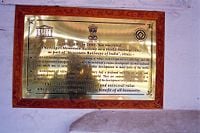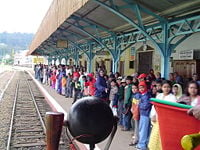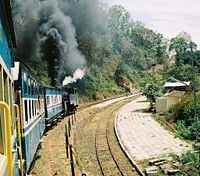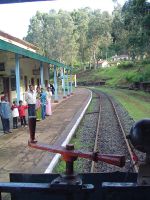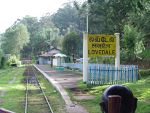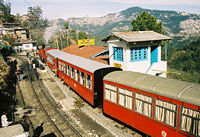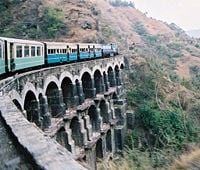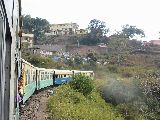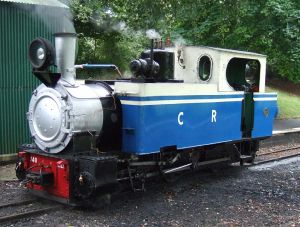Difference between revisions of "Mountain Railways of India" - New World Encyclopedia
Dan Davies (talk | contribs) |
Dan Davies (talk | contribs) |
||
| Line 526: | Line 526: | ||
=== References === | === References === | ||
| + | * Aitken, Bill. Exploring Indian Railways. Oxford India paperbacks. Delhi: Oxford University Press, 1994. ISBN 9780195631098 | ||
| + | * Bhandari, R. R. Exotic Indian Mountain Railways. New Delhi: Ministry of Railways, 1984. OCLC: 17776105 | ||
| + | * Bhandari, R. R. Indian Railways Glorious 150 Years. New Delhi: Publications Division, Ministry of Information & Broadcasting, Govt. of India, 2005. 9788123012544 | ||
| + | * Ghosh, Sitansu Sekhar. Railways in India—a Legend Origin & Development (1830-1980). Kolkata: Jogemaya Prokashani, 2006. ISBN 9788188374182 | ||
* {{cite book| author=Hughes, H.| year=1994| title=Indian Locomotives Part 3, Narrow Gauge, 1863-1940| publisher=The Continental Railway Circle| location=Harrow, UK| isbn=0-9521655-0-3| }} | * {{cite book| author=Hughes, H.| year=1994| title=Indian Locomotives Part 3, Narrow Gauge, 1863-1940| publisher=The Continental Railway Circle| location=Harrow, UK| isbn=0-9521655-0-3| }} | ||
| − | + | * Martin, Terry. The Iron Sherpa The Story of the Darjeeling Himalayan Railway, 1879-2006. Chester: RailRomances, 2006. ISBN 9781900622103 | |
| + | * Sahni, Jogendra Nath. Indian Railways; One Hundred Years, 1853 to 1953. New Delhi: Ministry of Railways (Railway Board), 1953. OCLC: 3153177 | ||
| + | * Srinivasan, Roopa, Manish Tiwari, and Sandeep Silas. Our Indian Railway Themes in India's Railway History. New Delhi: Foundation Books, 2006. ISBN 9788175963306 | ||
==External links== | ==External links== | ||
* [http://whc.unesco.org/en/list/944 UNESCO World Heritage Site: Mountain Railways of India]. Retrieved November 13, 2007. | * [http://whc.unesco.org/en/list/944 UNESCO World Heritage Site: Mountain Railways of India]. Retrieved November 13, 2007. | ||
| + | * [http://www.world-heritage-tour.org/asia/in/darjeeling/ghumStation.html UNESCO 360° view of Darjeeling Station]. Retrieved November 13, 2007. | ||
| + | * [http://www.steam.dial.pipex.com/internat.htm International Working Steam]. Retrieved November 13, 2007. | ||
* [http://www.acrossthedivide.com/wilkpedia/sikkim.htm Pictures of Darjeeling and the Toy Train]. Retrieved November 13, 2007. | * [http://www.acrossthedivide.com/wilkpedia/sikkim.htm Pictures of Darjeeling and the Toy Train]. Retrieved November 13, 2007. | ||
| − | |||
| − | |||
| − | |||
| − | |||
| − | |||
| − | |||
| − | |||
| − | |||
| − | |||
| − | |||
| − | |||
* [http://www.indianrail.gov.in/hill_2.html Indian railways site on the NMR]. Retrieved November 13, 2007. | * [http://www.indianrail.gov.in/hill_2.html Indian railways site on the NMR]. Retrieved November 13, 2007. | ||
* [http://www.railmuseum.org/nmr/ Railmuseum]. Retrieved November 13, 2007. | * [http://www.railmuseum.org/nmr/ Railmuseum]. Retrieved November 13, 2007. | ||
| − | |||
| − | |||
| − | |||
| − | |||
* [http://www.hindu.com/yw/2005/07/29/stories/2005072900030100.htm The toy train chugs on]. Retrieved November 13, 2007. | * [http://www.hindu.com/yw/2005/07/29/stories/2005072900030100.htm The toy train chugs on]. Retrieved November 13, 2007. | ||
| − | |||
| − | |||
* [http://hill-stations-india.com/hill-trains-india/kalka-shimla-railway.html Kalka Shimla Railway]. Retrieved November 13, 2007. | * [http://hill-stations-india.com/hill-trains-india/kalka-shimla-railway.html Kalka Shimla Railway]. Retrieved November 13, 2007. | ||
| − | |||
| − | |||
* [http://www.shimla-travel.com/shimla_railway.shtml Shimla Railway]. Retrieved November 13, 2007. | * [http://www.shimla-travel.com/shimla_railway.shtml Shimla Railway]. Retrieved November 13, 2007. | ||
| − | * [http://www. | + | * [http://www.tribuneindia.com/2003/20031108/windows/main1.htm The Tribune]. Retrieved November 13, 2007. |
| − | * [http://www. | + | |
| − | * [http:// | + | |
| − | * [http:// | + | <!--* [http://www.dhr.in/ ]. Retrieved November 13, 2007.--> |
| − | * [http://www. | + | <!—* [http://www.indianrail.gov.in/dm_hill.html ]. Retrieved November 13, 2007.—> |
| − | * [http:// | + | <!--* [http://www.backwoodsminiatures.com/ A kit to build a 'B' Class Locomotive in 4mm scale]. Retrieved November 13, 2007.—> |
| − | * [http://www. | + | <!--* [http://worsleyworks.co.uk Kits of the coaches of the DHR, Worsley Works Web]. Retrieved November 13, 2007.—> |
| + | <!--* [http://trainweb.org/railworld/MLR2/ Railworld: Photographs]. Retrieved November 13, 2007.—> | ||
| + | <!--* [http://blog.russnelson.com/railroads/neral-matheran-light-railway.html Neral Matheran Light Railway: Photographs of 2005 monsoon damage]. Retrieved November 13, 2007.—> | ||
| + | <!--* [http://spaces.msn.com/curumseydamjeearogyabhuv/ Matheran]. Retrieved November 13, 2007.—> | ||
| + | <!--* [http://www.flickr.com/photos/greenroutes/sets/72057594100248640/ A photo journey that will take you back in time]. Retrieved November 13, 2007.—> | ||
| + | <!--* [http://indiasteam.tripod.com/nmr.htm Images and info]. Retrieved November 13, 2007. | ||
| + | * [http://www.thehindubusinessline.com/life/2005/09/16/stories/2005091600080200.htm Toy train chugs on]. Retrieved November 13, 2007.—> | ||
| + | <!--* [http://twins.free.fr/travel/photos%20inde/page%202/pages/train%20ooty%202_jpg.htm Ooty train Photographs]. Retrieved November 13, 2007.—> | ||
| + | <!--* [http://deepsan.livejournal.com/93336.html 20 photos between Ooty and Coonoor]. Retrieved November 13, 2007.—> | ||
| + | <!--* [http://www.luxury-train-travel-tours-india.com/hill-trains-in-india/kalka-shimla-railway.html Kalka Shimla Railway]. Retrieved November 13, 2007.--> | ||
| + | <!--* [http://www.tribuneindia.com/2003/20031104/himachal.htm#1 ]. Retrieved November 13, 2007.—> | ||
| + | <!--* [http://www.indianadventureportal.com/trains/kalka-shimla-toy-train.html Kalka Shimla Toy Train]. Retrieved November 13, 2007.—> | ||
| + | <!--* [http://www.outlooktraveller.com/aspscripts/mag_art.asp?magid=214&page=1 ]. Retrieved November 13, 2007. | ||
| + | <!--* [http://www.pearcedale.com/c&b/DL.html#indi ]. Retrieved November 13, 2007. | ||
| + | * [http://mikes.railhistory.railfan.net/r019.html ]. Retrieved November 13, 2007.—> | ||
| + | <!--* [http://www.toshaliroyalview.com/shimla/travel-guide/kalka-shimla-railway-track/ Article on Kalka Shimla Rail]. Retrieved November 13, 2007.—> | ||
{{credits|Mountain_Railways_of_India|135016289|History_of_Darjeeling_Himalayan_Railway|165598918|Nilgiri Mountain Railway|162040213|Kalka-Shimla_Railway|168977790|Matheran_Hill_Railway|137862936|}} | {{credits|Mountain_Railways_of_India|135016289|History_of_Darjeeling_Himalayan_Railway|165598918|Nilgiri Mountain Railway|162040213|Kalka-Shimla_Railway|168977790|Matheran_Hill_Railway|137862936|}} | ||
Revision as of 21:16, 13 November 2007
| Mountain Railways of India* | |
|---|---|
| UNESCO World Heritage Site | |
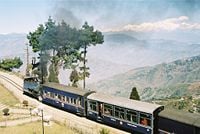
| |
| State Party | |
| Type | Cultural |
| Criteria | ii, iv |
| Reference | 944 |
| Region** | Asia-Pacific |
| Inscription history | |
| Inscription | 1999 (23rd Session) |
| Extensions | 2005 |
| * Name as inscribed on World Heritage List. ** Region as classified by UNESCO. | |
Several railways were built in the mountainous regions of India. Collectively they are known as the Mountain railways of India. Four of these railways are running in 2007:
- Darjeeling Himalayan Railway
- Nilgiri Mountain Railway
- Kalka-Shimla Railway
- Matheran Hill Railway
The collective designation refers to the current project by the Indian government to nominate a representative example of its historic railways to UNESCO as a World Heritage Site.
The Darjeeling Himalayan Railway was recognized in 1999, while the Nilgiri Mountain Railway was added as an extension to the site in 2005. They were recognized for being outstanding examples of bold, ingenious engineering solutions for the problem of establishing an effective rail link through a rugged, mountainous terrain.
Both the Kalka-Shimla Railway and the Matheran Hill Railway are on the tentative nomination list for that site.
Darjeeling Himalayan Railway
The Darjeeling Himalayan Railway, nicknamed the "Toy Train," is a 2 ft 0 in (610 mm) gauge narrow-gauge railway from Siliguri to Darjeeling in West Bengal, run by the Indian Railways.
It was built between 1879 and 1881 and is about 86 km long. The elevation level is from about 100 m at Siliguri to about 2,200 m at Darjeeling. It is still powered by a steam engine. A modern diesel engine is used for Darjeeling’s mail.
Since 1999 the train has been a World Heritage Site as listed by UNESCO. In 2005, UNESCO added the Nilgiri Mountain Railway as an extension to the original inscription.
History
A standard gauge railway connected Calcutta (now Kolkata) and Siliguri in 1878.[1] Siliguri, at the base of the Himalayas, was connected to Darjeeling by a cart road (the present day Hill Cart Road) on which "Tonga services" (carriage services) were available.[2] Franklin Prestage, an agent of Eastern Bengal Railway Company approached the government with a proposal of laying a steam tramway from Siliguri to Darjeeling.[2] The proposal was accepted in 1879 following the positive report of a committee formed by Sir Ashley Eden, the Lieutenant Governor of Bengal.[2] Construction started the same year.
Gillander Arbuthnot & Co. constructed the railway. The stretch from Siliguri to Kurseong was opened on 23 August 1880, while the official opening of the line up to Darjeeling was on 4 July 1881.[1] Several engineering adjustments were made later in order to ease the gradient of the rails.[2][3] Despite natural calamities such as an earthquake in 1897 and a major cyclone in 1899[3] the DHR continued to improve with new extension lines, and the passenger as well as goods carrying were increasing.[3] DHR started to face competition from bus services that started operating in the Hill Cart Road, and took less time than the railway to reach Darjeeling. During World War 2, DHR played a vital role transporting military personnel and supplies to the numerous camps around Ghum and Darjeeling.[3]
After the independence of India, DHR was absorbed in the Indian Railway, and became a part of the Northeast Frontier Railway zone in 1958.[3] In 1962, the line was realigned at Siliguri and extended by nearly 4 miles (6 km) to New Jalpaiguri (NJP) to meet the new broad gauge line there. DHR remained closed for 18 months during the hostile period of Gorkhaland Movement in 1988–1989.[3] DHR was declared a World Heritage Site by UNESCO in 1999, only the second railway to have this honour bestowed upon it,[4] the first one being Semmering Railway of Austria in 1998.
The Darjeeling Himalayan Railway, nicknamed the "Toy Train," is a 2 ft 0 in (610 mm) narrow-gauge railway from Siliguri to Darjeeling in the Indian state of West Bengal, run by the Indian Railways.
A standard gauge railway connected Calcutta (now Kolkata) and Siliguri in 1878.[1] Siliguri, located at the base of the Himalayas, was connected to Darjeeling by a cart road (the present day Hill Cart Road) on which tonga services were available.[5] Franklin Prestage, an agent of Eastern Bengal Railway Company approached the government with a proposal of laying a steam tramway from Siliguri to Darjeeling.[5] Sir Ashley Eden, the Lieutenant Governor of Bengal, formed a committee to assess the feasibility of the project. The proposal was accepted in 1879 following the positive report of the committee.[5] Construction started the same year.
Gillander Arbuthnot & Company was given the responsibility of construction. By March 1880, the line was extended up to Tindharia. Lord Lytton, the first Viceroy to visit Darjeeling was conveyed in the train up to Tindharia.[5] The stretch from Siliguri to Kurseong was opened on 23 August 1880. The Siliguri to Darjeeling track was inaugurated on 4 July 1881.[1] The name of the rail company was promptly changed to Darjeeling Himalayan Railway Company. Initially the alignment of the railroad followed Hill Cart Road. However, it became apparent that in some areas the steepness of the road was more than the locomotives could easily maneuver. In 1882 four loops and four reverses (zig-zags) were constructed between Sukna and Gayabari to ease the gradient.[3] The line was extended by a quarter of mile to Darjeeling Bazar in 1886.[1] The Darjeeling station was renovated in 1891 while Kurseong got a new station building and storage shed in 1896.[3] Darjeeling Himalayan Railway (DHR) suffered from an earthquake in 1897 and a major cyclone in 1899.[3] By 1909–1910, DHR was carrying 174,000 passengers and 47,000 tons of goods annually.[3] The first bogie carriages entered service, replacing very basic 4 wheel carriages. DHR extension lines were constructed up to Kishanganj in 1914, and Gielkhola in 1915.[1] At Tindharia the railway works were relocated from behind the loco shed to a new and extensive site.[3]
The Batasia loop was constructed in 1919, eliminating problems by creating easier gradients on the ascent from Darjeeling.[3] However, DHR started to face competition from bus services that started operating in the Hill Cart Road, and took less time than the railway to reach Darjeeling. In 1934, a major earthquake in Bihar shook all of Northeast India. Many buildings in Darjeeling were heavily damaged and the railway was also badly affected, although it soon recovered and played a vital role in transporting repair materials.[3] During World War 2, DHR played a vital role transporting military personnel and supplies to the numerous camps around Ghum and Darjeeling.[3]
After the Independence of India, DHR was purchased by the Indian Government and was absorbed into the Indian Government Railways organisation.[3] DHR came under the management of the Assam Railways organisation. In 1952, Assam Railway, including DHR, became part of the North Eastern Railway Zone[3] and later in 1958, a part of the Northeast Frontier Railway Zone of Indian Railway.[3] In 1962, the line was realigned at Siliguri and extended by nearly 4 miles (6 km) to New Jalpaiguri (NJP) to meet the new broad gauge line there.[3] It opened for freight that year and for passengers in 1964. The loco shed and carriage depot at Siliguri Junction were relocated to NJP.
DHR remained closed for 18 months during the hostile period of Gorkhaland Movement in 1988–1989.[3] DHR was declared a World Heritage Site by UNESCO in 1999, becoming only the second railway in the world to have this honour bestowed upon it,[4] the first one being Semmering Railway of Austria in 1998.
A description from 1920s
The Darjeeling Himalayan Railway has long been viewed with affection and enthusiasm by travellers to the region, and the Earl of Ronaldshay gave the following description of a journey in the early 1920s:
"Siliguri is palpably a place of meeting.[.....] The discovery that here the metre gauge system ends and the two foot gauge of the Darjeeling-Himalayan railway begins, confirms what all these things hint at.[....]One steps into a railway carriage which might easily be mistaken for a toy, and the whimsical idea seizes hold of one that one has accidentally stumbled into Lilliput. With a noisy fuss out of all proportion to its size the engine gives a jerk - and starts.[....] No special mechanical device such as a rack is employed - unless, indeed, one can so describe the squat and stolid hill-man who sits perched over the forward buffers of the engine and scatters sand on the rails when the wheels of the engine lose their grip of the metals and race, with the noise of a giant spring running down when the control has been removed. Sometimes we cross our own track after completing the circuit of a cone, at others we zigzag backwards and forwards; but always we climb at a steady gradient - so steady that if one embarks in a trolley at Ghum, the highest point on the line, the initial push supplies all the energy necessary to carry one to the bottom." [6]
The Route
- New Jalpaiguri - the railway was extended to the south in 1964 to meet the new Broad gauge to Assam. Where the two met, New Jalpaiguri was created.
- Siliguri Town - original southern terminus of the line.
- Siliguri Junction - became a major station only when a new metre-gauge line was built to Assam in the early 1950s
- Sukna - this station marks the change in the landscape from the flat plains to the wooded lower slopes of the mountains. The gradient of the railway changes dramatically.
Loop No.1 was in the woods above Sukna. It was removed after flood damage in 1991. The site is now lost in the forest.
- Rangtong
A short distance above Rangtong there is a water tank. This was a better position for the tank than in the station, both in terms of water supply and distance between other water tanks.
When Loop 2 was removed in 1942, again following flood damage, a new reverse, No.1, was added, creating the longest reverse run.
Loop No.3 is at Chunbatti. This is now the lowest loop.
Reverses No.2 & 3 are between Chunbatti and Tindharia.
- Tindharia - this is a major station on the line as below the station is the workshops. There is also an office for the engineers and a large locomotive shed, all on a separate site.
Immediately above the station are three sidings; these were used to inspect the carriage while the locomotive was changed, before the train continued towards Darjeeling.
Agony Point is the name given to loop No.4. It comes from the shape of the loop which comes to an apex which is the tightest curve on the line.
- Gayabari
Reverse No.6 is the last reverse on the climb.
- Mahanadi
- Kurseong - There is a shed here and a few sidings adjacent to the main line, but the station proper is a dead end. Up trains must reverse out of the station (across a busy road junction) before they can continue on their climb. It is said that the station was built this way so that the train could enter a secure yard and stay there while the passengers left the train for refreshments.
Above Kurseong station, the railway runs through the bazaar. Trains skirt the front of shops and market stalls on this busy stretch of road.
- Tung
- Dilaram
- Sonada
- Rangbul
- Jor Bungalow
- Ghum - Summit of the line and highest station in India. Now includes a museum on the first floor of the station building with larger exhibits in the old goods yard.
Batasia Loop
- Darjeeling
The furthest reach of the line was to Darjeeling Bazaar, a goods-only line and now lost under the road surface and small buildings.
Locomotives
All the steam locomotives currently in use on the railway are of the 'B' Class, a design built between 1889 and 1925. A total of 34 were built but by 2005 only 12 remained on the railway and in use (or under repair).
No.787 has been rebuilt with oil firing. This was originally installed to work on the same principle as that used on Nilgiri Mountain Railway No.37395. To operate the oil burner and an electrically driven feed pump, a diesel-powered generator was fitted and to power the braking system, a diesel-powered compressor was fitted. Additionally the locomotive was fitted with a feed water heater. The overall result was a dramatic change in the appearance of the locomotive.
In March 2001, No.794 was transferred to the Matheran Hill Railway to allow a 'Joy Train' (Steam-hauled tourist train) to be operated on that railway. It did not, however, enter service there until May 2002.
Only one DHR steam locomotive has been taken out of India, No.778 (originally No.19). After many years out of use in an American museum, it was sold to an enthusiast in the UK and restored to working order. It is now based on a private railway in Oxfordshire but has run on the Ffestiniog Railway.
Two diesel locomotives are in use, Nos.604 & 605. They are both members of the NDM6 class. Both were originally intended for use on the Matheran Hill Railway and are identical to the four locomotives actually delivered there.
In 1910 the railway purchased the third Garratt locomotive built, a D class 0-4-0+0-4-0.
In popular culture
The Darjeeling Himalayan Railway has long been viewed with affection and enthusiasm by travellers to the region, and the Earl of Ronaldshay gave the following description of a journey in the early 1920s:
"Siliguri is palpably a place of meeting.[.....] The discovery that here the metre gauge system ends and the two foot gauge of the Darjeeling-Himalayan railway begins, confirms what all these things hint at.[....]One steps into a railway carriage which might easily be mistaken for a toy, and the whimsical idea seizes hold of one that one has accidentally stumbled into Lilliput. With a noisy fuss out of all proportion to its size the engine gives a jerk - and starts.[....] No special mechanical device such as a rack is employed - unless, indeed, one can so describe the squat and stolid hill-man who sits perched over the forward buffers of the engine and scatters sand on the rails when the wheels of the engine lose their grip of the metals and race, with the noise of a giant spring running down when the control has been removed. Sometimes we cross our own track after completing the circuit of a cone, at others we zigzag backwards and forwards; but always we climb at a steady gradient - so steady that if one embarks in a trolley at Ghum, the highest point on the line, the initial push supplies all the energy necessary to carry one to the bottom."[7]
The trip up to Darjeeling on railway has changed little since that time, and continues to delight travellers and rail enthusiasts, so much so that it has its own preservation and support group, the Darjeeling Himalayan Railway Society.[8]
Several Bollywood movies have portrayed the railway. Especially popular was the song Mere sapno ki rani from the film Aradhana where the protagonist Rajesh Khanna tries to woo heroine Sharmila Tagore who was riding in the train.[9][10] Other notable films include Jhumroo, Parineeta and Raju Ban Gaya Gentleman. Director Wes Anderson has announced that he will once again be joining Owen Wilson to co-direct a movie entitled The Darjeeling Limited.[11] The movie will follow three brothers, (Owen Wilson, Adrien Brody, and Jason Schwartzman), as they travel throughout India on the railway.
Nilgiri Mountain Railway
The Nilgiri Mountain Railway (NMR) connects the town of Mettupalayam with the hill station of Udagamandalam, in the Nilgiri Hills of southern India. Both towns are in the state of Tamil Nadu. It is the only rack railway in India, and uses the Abt system.
History
The Nilgiri Mountain railway is one of the oldest mountain railways in India. Under consideration since 1845, the line was finally opened by the British in 1899, and was initially operated by the Madras Railway Company. The railway is one of the few in the world dependent on steam locomotives.
The Palghat division of the Indian Railways, which operates the NMR, incurs an annual shortfall of Rs 4 crores, (~1 million USD). During the Centenary celebrations of Nilgiri Mountain Railway in 1999 Railway Minister Nitish Kumar announced that the line would soon be electrified.
In July 2005, UNESCO added the NMR as an extension to the World Heritage Site of Darjeeling Himalayan Railway[12] after it satisfied the necessary criteria, thus forcing abandonment of modernisation plans.
Operation
The NMR track is 1,000 mm (3 ft 3⅜ in) gauge and the railway is isolated from other narrow gauge lines.
Below Coonoor the line uses the rack and pinion system to climb the steep gradient. On the rack section trains are operated by steam rack locomotives manufactured by the Swiss Locomotive and Machine Works of Winterthur in Switzerland, which are always marshalled at the downhill (Mettupalayam) end of the train.
The average gradient in this rack section is 1 in 24.5, with a maximum of 1 in 12.
As of 2007, there is one train a day over the rack section, starting from Mettupalayam at 7.10 AM reaches Ooty at noon. Return train starts from Mettupalayam at 3 PM and reaching Ooty at 6.35 PM. The train is scheduled both ways connecting it to the Nilgiri Express (Mettupplalayam-Chennai) whose timings are :
Arrival (from Chennai) : 5.30 AM approx
Departure (to Chennai) : 7.30 PM
It is advisable to book tickets for NMR in advance especially during peak season. Ticket booking is similar to other conventional trains and can be done via official website also.
Station code : UAM
Official name of the train: Udagamandalam-Mettupalayam Passenger
Fare - 1st class : Rs. 135
2nd class : Rs. 25
Between Coonoor and Udagamandalam the train is operated by a YDM4 diesel locomotive using conventional rail adhesion principles. On this section the locomotive is always at the Coonoor end of the train as although the line is not steep enough to need a rack rail the ruling gradient out of Coonoor is still very steep at 1 in 25.
Between Coonoor and Udagamandalam (in 2005) there are four daily trains each way.
The diesel locomotives can only operate on the upper section. The steam locomotives can be used either with or without the rack section when required.
The majority of repairs to the locomotives are carried out at Coonoor shed but many of the steam locomotives have been rebuilt at the Golden Rock Workshops. Carriages are repaired at Mettupalayam but, like the locomotives, are taken to one of the big railway workshops for major work.
The Route
The train covers a distance of 46 km (28 miles), travels through 208 curves, 16 tunnels, and 250 bridges. The uphill journey takes around 290 minutes and the downhill journey 215 minutes.
- Mettupalayam - 0km, 1069ft above sea level - Junction with the Broad Gauge line from Coimbatore. Passengers cross the platform to the Nilgiri train. There is a small locomotive shed here and the carriage workshops for the line.
- Leaving Mettupalayum, the line is adhesion worked and actually drops for a short distance before crossing a wide river called Bhavaani and starting to climb gently.
- Kallar - 8km, 1260ft - Closed as a passenger station, this is where the rack rail begins. As the train leaves the station, the gradient is 1 in 12.
- Adderly - 13km, 2390ft - Closed as a passenger station but is still a water stop.
- Hillgrove - 18km, 3580ft - Block post and water stop as well as having refreshments for passengers.
- Runneymede - 21km, 4612ft - Closed as a passenger station but is still a water stop.
- Kateri Road - 25km, 5070ft - Closed as a passenger station, trains do not stop here.
- Coonoor - 28km, 5616ft - main intermediate station on the line at site of the locomotive workshops as well as the top end of the rack rail. Trains must reverse a short distance before continuing their climb to Ooty. It is normal for the locomotive to be changed here with diesel traction being normal for all trains to Ooty.
- Wellington - 29km, 5804ft
- Aruvankadu - 32km, 6144ft
- Ketti - 38km, 6864ft
- Lovedale - 42km, 7694ft
- From a short distance before Lovedale the line descends all the way into Ooty.
- Ooty - 46km, 7228ft (2200 m).
Kalka-Shimla Railway
The Kalka-Shimla Railway is a 2 ft 6 in (762 mm) narrow gauge railway in North-West India travelling along a mostly mountainous route from Kalka to Shimla. It is known for breathtaking views of the hills and surrounding vilages, and for having the greatest incline over its 96km stretch.
History
Shimla was discovered by the British shortly after the first Anglo-Gurkha war. By the 1830s, Shimla had already developed as a major base for the British. It became the Summer Capital of British India in 1864.
Construction and initial operation
Bhalkoo, the "illiterate genius" had played a vital role in the construction of the Kalka-Shimla rail line. The contract for construction was awarded to the Delhi-Umbala Company in 1898 at an estimated cost of Rs 86,78,500, however, the cost doubled during execution of the project and it was finally purchased by the state in 1906 for Rs 1,71,07,748. The 96.54 km (60 mi) line was opened for traffic November 9, 1903. Because of the high capital and maintenance cost, coupled with peculiar working conditions, the Kalka-Shimla Railway was allowed to charge fares that were higher than the prevailing tariffs on other lines. However, even this was not good enough to sustain the company and the Government had to purchase it on January 1, 1906.
20th century
21st century
For about a week starting on September 11 2007, an expert team from UNESCO will visit the railway to review and inspect the railway for possible selection as a World Heritage Site. After the team submits its report, the status of the railway's selection would likely be made in July 2008. If the selection is made, the railway would become the fourth rail property in India to be selected.[13]In mid-August 2007, the government of Himachal Pradesh declared the railway a heritage property in preparation for its review in September.[14]
Route
The Kalka-Shimla Railway was built to connect Shimla, the summer capital of India during the British Raj, with the Indian rail system. Now, Shimla is the capital city of Himachal Pradesh and Kalka is a town in the Panchkula district of Haryana. Spectacular scenery along the whole route, and the marvels of its construction, keeps the traveler on this line spell bound. On leaving Kalka, 656 meters (2,152.2 ft) above sea level, the railway enters the foothills and immediately commences its climb.
Stations
The route offers a panoramic feast of the picturesque Himalayas from the shivalik foot hills at Kalka to several important points such as Dharampur, Solan, Kandaghat, Taradevi, Barog, Salogra, Summerhill and Shimla at an altitude of 2,076 meters (6,811 ft).
Engineering
The Kalka Shimla Railway runs through 103 tunnels (one is not in use; so only 102 in service). The longest tunnel is at Barog, and is named after the engineer in charge of construction. Mr Barog apparently committed suicide after making a mistake in laying the alignment. This tunnel is 1,143.61 meters (3,752 ft) long and remained for a long time the second longest tunnel on the Indian Railways. It is a straight tunnel, passing through fissured sandstone.
The line has 864 bridges, one of which is a 18.29 metre (60 ft) plate girder span and steel truss. The others are viaducts with multi-arched galleries like the ancient Roman aqueducts. Bridge No. 493, historically known as the "Arch Gallery," situated between Kandaghat and Kanoh stations, is an arch bridge in three stages, constructed with stone masonry. Bridge No. 226; between Sonwara and Dharampur is an arch gallery bridge having 5 tier galleries of multiple spans, constructed with stone masonry and bridging a deep valley surrounded by high peaks.
The railway has a ruling gradient of 1 in 25 or 4%. It has 919 curves, the sharpest being 48 degrees (a radius of 37.47 m or 122.93 feet). Climbing from 656 meters (2,152.2 ft), the line terminates at an elevation of 2,076 meters (6,811 ft) at Shimla.
Locomotives
The first locomotives to arrive were two class "B" 0-4-0ST from the famous Darjeeling Himalayan Railway. These were built as 2 ft 0 in (610 mm) gauge engines, but were converted to 2 ft 6 in (762 mm) gauge in 1901. They were not large enough for the job, and were sold on in 1908. They were followed by 10 engines with a 0-4-2T wheel arrangement of a slightly larger design, introduced in 1902. These locos weighed 21.5 tons (21.85 tonnes), and had 30" (762 mm) driving wheels, and 12"x16" (304.8 mm x 406.4 mm) cylinders. They were later classified into the "B" class by the North Western State Railways. All these locos were constructed by the British firm of Sharp Stewart.
Larger locomotives were introduced in the form of an 2-6-2T, of which 30 were built with slight variations between 1904 and 1910. Built by the Hunslet and the North British Locomotive Company, these locomotives were about 35 tons (35.56 tonnes), with 30" (762 mm) drivers and 14"x16" (355.6 mm x 406.4 mm) cylinders. These locomotives, later classed K and K2 by the North Western State Railways, subsequently handled the bulk of the railways traffic during the steam era. A pair of Kitson-Meyer 2-6-2+2-6-2 articulated locomotives, classed TD, were supplied in 1928. They quickly fell into disfavour, as it often took all day for enough freight to be assembled to justify operating a goods train hauled by one of these locos. Shippers looking for a faster service started to turn to road transport. These 68 ton (69.09 tonnes) locomotives were soon transferred to the Kangra Valley Railway, and subsequently ended up converted to 1,000 mm (3 ft 3⅜ in) gauge in Pakistan.
Trains
- Shivalik Deluxe Express
- Himalayan Queen
- Rail Car
- Other Local trains
Railcars
Rail cars. which looked like buses on the rail, were used to transport upper class travellers. The fare for these cars was almost double of the first class ticket. The travel time by these rail cars was less than three hours from Kalka to Simla where as trains used to take between Six to Seven hours to complete this journey.
Matheran Hill Railway
Matheran Hill Railway is a heritage railway in Maharashtra, India. It was built between 1901 and 1907 by Abdul Hussein Adamjee Peerbhoy, financed by his father Sir Adamjee Peerbhoy at the cost of Rs.16,00,000.[15]The railway covers a distance of 20 kilometres (12.67 miles), over large swathes of forest territory connecting Neral to Matheran in the Western Ghats hills near Karjat and Mumbai.
The railway is a 2 ft 0 in (610 mm) narrow gauge railway. Neral also has a broad gauge station which is on the busy Mumbai-Pune route.
The railways comes under the Central Railways and is being promoted as a future World Heritage Site.
The railway was closed by flood damage during 2005 and was not expected to re-open before April 2007.[16]Contrary to those expectations, the first run on the repaired railway was on 5 March 2007.[17]
Locomotives
Steam locomotives
| MHR No. | ISR No. | Builder | Builders No. | Date | Current Location |
|---|---|---|---|---|---|
| 1 | 738 | O & K | 1766 | 1905 | Bombay |
| 2 | 739 | O & K | 2342 | 1907 | Delhi |
| 3 | 740 | O & K | 2343 | 1907 | U.K. (LBR) |
| 4 | 741 | O & K | 1767 | 1905 | Matheran |
Darjeeling Himalayan Railway No. 794 was transferred here in 2001
Diesel locomotives
| ISR No. | Class | Builder | Builders No. | Date | Current Status | Notes |
|---|---|---|---|---|---|---|
| 500 | NDM1 | Jung | 12108 | 1956 | Not Known | From Kalka Shimla Railway |
| 501 | NDM1 | Jung | 12109 | 1956 | In Service | Originally No.750 |
| 502 | NDM1 | Jung | 12110 | 1956 | Not Known | Originally No.751 |
| 503 | NDM1 | Jung | 12111 | 1956 | Dismantled | Originally No.752 |
| 504 | NDM1 | Jung | 12105 | 1956 | Not Known | From Kalka Shimla Railway |
| 505 | NDM1 | Jung | 12107 | 1956 | Dismantled | From Kalka Shimla Railway |
| 505 | NDM1 | Jung | 12107 | 1956 | Not Known | From Kalka Shimla Railway |
| 600 | NDM6 | ? | ? | ? | In Service | visible in Railworld photos |
Currently Class NDM1 and NDM6 locomotives are in use.
See also
- Matheran
- Darjeeling Himalayan Railway
- Nilgiri Mountain Railway
- Ootacamund
- Indian Railways
Notes
- ↑ 1.0 1.1 1.2 1.3 1.4 1.5 DHR and Its Development. About DHR,dhr.in. Darjeeling Himalayan Railway, NF Railway, India. Retrieved 2007-02-24.
- ↑ 2.0 2.1 2.2 2.3 DHR History. darjeelingnews.net. Darjeelingnews. Retrieved 2007-02-24.
- ↑ 3.00 3.01 3.02 3.03 3.04 3.05 3.06 3.07 3.08 3.09 3.10 3.11 3.12 3.13 3.14 3.15 3.16 3.17 3.18 Whittle, Paul; Terry Martin. A Brief History of the DHR. History and A Trip Up the Line. Darjeeling Himalayan Railway Society. Retrieved 2007-02-24.
- ↑ 4.0 4.1 Mountain Railways of India. UNESCO World Heritage Centre. Retrieved 2006-04-30.
- ↑ 5.0 5.1 5.2 5.3 DHR History. darjeelingnews.net. Darjeelingnews. Retrieved 2007-02-24.
- ↑ The Earl of Ronaldshay Lands of the Thunderbolt. Sikhim, Chumbi and Bhutan (London: Constable & Company) 1923 pp10-12
- ↑ The Earl of Ronaldshay Lands of the Thunderbolt. Sikhim, Chumbi and Bhutan (London: Constable & Company) 1923 pp10-12
- ↑ Welcome to the DHRS. Darjeeling Himalayan Railway Society. Retrieved 2007-03-09.
- ↑ Mahalingam, Sudha (March 2001). Darjeeling: Where the journey is the destination. Travelogues. Outlook Traveller.. Outlook Publishing (India) Private Limited. Retrieved 2007-03-09.
- ↑ Darjeeling Toy Train. Theme India: Train Tourism in India. IndiaLine. Retrieved 2007-03-09.
- ↑ The Darjeeling Limited. Internet Movie Database Inc.. Retrieved 2007-03-09.
- ↑ NMR added as a World Heritage Site
- ↑ Press Trust of India. "Toy train set to enter UNESCO heritage list", Hindustan Times, 2007-08-08. Retrieved 2007-08-09.
- ↑ "HP declares Kalka-Shimla railway as 'heritage' property", The Hindu, 2007-08-13. Retrieved 2007-08-13.
- ↑ Image:Matheran_Railway_Wala.jpg
- ↑ Why you still can’t take the toy train to Matheran
- ↑ Uphill Journey Resumes
ReferencesISBN links support NWE through referral fees
- Aitken, Bill. Exploring Indian Railways. Oxford India paperbacks. Delhi: Oxford University Press, 1994. ISBN 9780195631098
- Bhandari, R. R. Exotic Indian Mountain Railways. New Delhi: Ministry of Railways, 1984. OCLC: 17776105
- Bhandari, R. R. Indian Railways Glorious 150 Years. New Delhi: Publications Division, Ministry of Information & Broadcasting, Govt. of India, 2005. 9788123012544
- Ghosh, Sitansu Sekhar. Railways in India—a Legend Origin & Development (1830-1980). Kolkata: Jogemaya Prokashani, 2006. ISBN 9788188374182
- Hughes, H. (1994). Indian Locomotives Part 3, Narrow Gauge, 1863-1940. Harrow, UK: The Continental Railway Circle. ISBN 0-9521655-0-3.
- Martin, Terry. The Iron Sherpa The Story of the Darjeeling Himalayan Railway, 1879-2006. Chester: RailRomances, 2006. ISBN 9781900622103
- Sahni, Jogendra Nath. Indian Railways; One Hundred Years, 1853 to 1953. New Delhi: Ministry of Railways (Railway Board), 1953. OCLC: 3153177
- Srinivasan, Roopa, Manish Tiwari, and Sandeep Silas. Our Indian Railway Themes in India's Railway History. New Delhi: Foundation Books, 2006. ISBN 9788175963306
External links
- UNESCO World Heritage Site: Mountain Railways of India. Retrieved November 13, 2007.
- UNESCO 360° view of Darjeeling Station. Retrieved November 13, 2007.
- International Working Steam. Retrieved November 13, 2007.
- Pictures of Darjeeling and the Toy Train. Retrieved November 13, 2007.
- Indian railways site on the NMR. Retrieved November 13, 2007.
- Railmuseum. Retrieved November 13, 2007.
- The toy train chugs on. Retrieved November 13, 2007.
- Kalka Shimla Railway. Retrieved November 13, 2007.
- Shimla Railway. Retrieved November 13, 2007.
- The Tribune. Retrieved November 13, 2007.
Credits
New World Encyclopedia writers and editors rewrote and completed the Wikipedia article in accordance with New World Encyclopedia standards. This article abides by terms of the Creative Commons CC-by-sa 3.0 License (CC-by-sa), which may be used and disseminated with proper attribution. Credit is due under the terms of this license that can reference both the New World Encyclopedia contributors and the selfless volunteer contributors of the Wikimedia Foundation. To cite this article click here for a list of acceptable citing formats.The history of earlier contributions by wikipedians is accessible to researchers here:
- Mountain_Railways_of_India history
- History_of_Darjeeling_Himalayan_Railway history
- Mountain Railway&oldid=162040213 Nilgiri Mountain Railway Mountain Railway&action=history history
- Kalka-Shimla_Railway history
- Matheran_Hill_Railway history
The history of this article since it was imported to New World Encyclopedia:
Note: Some restrictions may apply to use of individual images which are separately licensed.
